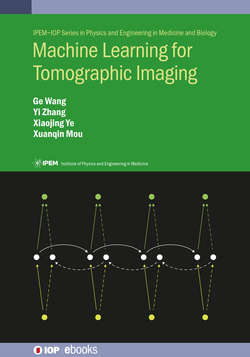Читать книгу Machine Learning for Tomographic Imaging - Professor Ge Wang - Страница 20
На сайте Литреса книга снята с продажи.
IOP Publishing Machine Learning for Tomographic Imaging Ge Wang, Yi Zhang, Xiaojing Ye and Xuanqin Mou Chapter 1 Background knowledge 1.1 Imaging principles and a priori information 1.1.1 Overview
ОглавлениеTomography is an imaging technology that studies an object with externally measured data generated by some physical means such as x-ray radiation, where data are projections in the form of line integrals of an object function from different angles of view. This kind of imaging technique can be used to produce images of hidden 3D structures in an opaque object non-destructively, even though the object is not transparent to the human eye. Seeing through a patient’s body is highly valuable for medicine. Hence, modern medicine is, in a sense, enabled by tomography.
With major discoveries in physics, such as x-ray radiation and magnetic resonance, an object can now be imaged using various mechanisms. X-ray photons easily penetrate most every-day materials, including human tissues, and produce line integral information on the linear attenuation coefficient that characterizes the interactions between the materials and x-ray radiation. Various types of materials have different linear attenuation coefficients. From sufficiently many x-ray projections, a cross-sectional image can be reconstructed, which is called computed tomography (CT). In such a reconstructed image of a patient, bone, soft tissue, and fat can be clearly discriminated, and anatomical features can be well defined. Magnetic resonance imaging (MRI) is another important imaging modality. It takes advantage of nuclear spins (in particular spins of hydrogen nuclei) to generate signals when the spins are aligned in an external magnetic field, excited by radio frequency pulses, and then relaxed to their steady states. During the relaxation process, various tissues have different proton densities and take different times to relax, thereby exhibiting distinct characteristics. The relaxation time has two main aspects: T1 (longitudinal relaxation time) and T2 (transverse relaxation time). While CT images enjoy excellent bone–tissue and air–tissue contrasts, MRI images give rich soft tissue contrasts and functional information.
In addition to x-ray CT and MRI, there are multiple other tomographic imaging modalities. Importantly, nuclear emission imaging concentrates on physiological functions such as blood flow and metabolism. In this category, positron-emission tomography (PET) and single-photon emission computed tomography (SPECT) are the primary modes of nuclear tomography (Leigh et al 2002, Zeng 2009).
A PET system detects pairs of gamma rays generated by a positron-emitting radionuclide, such as fluorine-18, which is introduced into a patient inside a biologically active molecule called a radioactive tracer. A pair of gamma ray photons is emitted in opposite directions from the radioactive tracer. Hence, the PET scanner utilizes their linearity and simultaneity to detect the emission event along a corresponding line of response defined by two detectors facing each other. Specifically, if two gamma ray photons are simultaneously (within a time window of 10–20 ns) detected, then a signal is recorded for the line of response. From these data, a distribution of the radioactive tracer can be reconstructed. Similarly, SPECT reconstructs distributions of radioactive tracers from gamma ray induced signals, but these tracers only emit gamma ray photons individually, and a metallic collimator is needed to determine the line path along which a gamma ray photon travels. In both the PET and SPECT cases, the tracer nuclides require a patient to contain a radiation source in his/her body, and the detector measures radiation-induced data externally for image reconstruction.
Furthermore, we can also utilize ultrasound and light waves for imaging purposes, which are called ultrasound imaging and optical imaging, respectively. Generally speaking, for any physical measurement on an object of interest, as long as the data do not directly reflect structural features, a so-called ‘inverse’ process will be needed to estimate these features from the indirect data. Tomography is a very important class of inverse problems, targeting cross-sectional/volumetric image formation. In the next section, we will heuristically explain the CT problem as a specific example.
